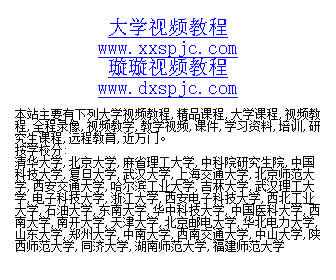中文名称:Maya构建阴影网格教程
英文名称:DIGITAL.TUTORS.BUILDING.ADVANCED.SHADING.NETWORKS
资源类型:Bin
地区:美国
语言:英语
简介:
转自TLF
![《Maya构建阴影网格教程》(DIGITAL.TUTORS.BUILDING.ADVANCED.SHADING.NETWORKS)[Bin]](http://pic.dxspjc.com/dx_pic/2005082909/20050829090854590.jpg)
语言: 英语
网址: http://www.digitaltutors.com/store/product...2&cat=30&page=1
类型: 教材
Maya关于构建Shading(阴暗,对比)网格的教材。
Master the daunting task of building shader networks that go beyond the normal connections. Learn how to combine expressions, particles and utility nodes to create complex shaders
QUOTEIntroduction This lesson will introduce you to the topics that will be covered over the span of this training kit.
Getting Started with Shading Networks In this lesson we will explore the process of combining multiple textures into one texture to create a complex camouflage pattern.
Iridescence Shading Network In this lesson we will construct a shading network that can add realistic iridescent qualities to surfaces such as bubbles.
Realistic Lighting Shaders In this lesson we will construct a shading network that can give several lighting characteristics to a single object.
Curve-Controlled Shaders (part 1) This lesson will focus on constructing a network that can use a NURBS curve to create realistic animated textures.
Curve-Controlled Shaders (part 2) Continuing from the previous lesson, we will look at creating an animated texture based on NURBS curves.
Light-Based Shading Networks This lesson will focus on how to realistically simulate light coming from a computer monitor or television set.
Reusing Textures in Maya In this lesson we will construct a shading network that will make a single texture look different on each object that it is applied to.
The Hologram Shader (part 1) In this lesson we will begin constructing a shading network that can simulate a holographic emblem on a credit card.
The Hologram Shader (part 2) Continuing from the previous lesson, we will finish assembling an interactive hologram shading network.
Particle-Based Shading Networks (part 1) This lesson will begin the process of building an expression-controlled network that can generate textures based on particle collisions.
Particle-Based Shading Networks (part 2) Continuing from the previous lesson, we will write the expressions for the particles of the paintball gun.
Particle-Based Shading Networks (part 3) Continuing from the previous lesson, we will begin writing the expression that can generate textures based on the particle expression from the last lesson.
Particle-Based Shading Networks (part 4) In this lesson we will finish writing the expression to generate the particle-based textures.
Particle-Based Shading Networks (part 5) Now we can construct a shading network that is able to change whenever particles strike a certain surface.
Texture-Based Particles (part 1) In this lesson we will begin constructing a shading network that is able to dynamically control particles.
Texture-Based Particles (part 2) In this lesson we will write the necessary expressions for the shading network created in the previous lesson.
Texture-Based Particles (part 3) Now we can import and use the image sequence that was created in the previous lesson.
Texture-Based Particles (part 4) In this lesson we will construct a shading network that is able to add white areas to the water wherever the NURBS torus touches its surface.
Texture-Based Particles (part 5) In this final lesson we will set up the steam particles to be emitted wherever the NURBS torus touches the water surface.

